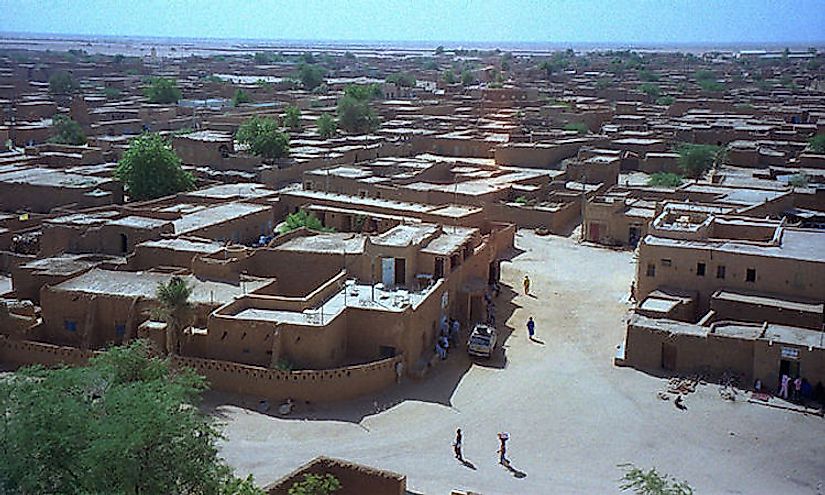UNESCO World Heritage Sites In Niger

Niger’s inscribed sites highlight its ecological richness and its historical role as the “Gateway to the Sahara.” Niger’s ecological diversity is well represented by its two natural heritage sites. The country has one cultural heritage site, which is a testament to its cultural and historical pride. The UNESCO World Heritage Sites of Niger are discussed below:
UNESCO World Heritage Sites In Niger
Agadez Historic Center
The Agadez Historic Center was inscribed as a cultural heritage site in 2013. Agadez is a historic city situated on the southern edge of the Sahara Desert. The city dates back to the 15th and 16th centuries and was established parallel to the establishment of the Sultanate of Aïr. The town facilitated the consolidation of Tuareg tribes who settled around street patterns still present day. Agadez had become a center of the caravan trade across the Sahara Desert before it was captured by the French in 1900. The historic center is comprised of earthen dwellings including houses, palaces, and religious buildings. A 27-meter tall minaret made of mudbrick is one of the most notable structures, being the tallest of its kind in the world. The town’s structures have remained intact over time, with the current street patterns being the original encampments established by the Tuareg tribes. Agadez Historic Center is culturally significant since it reflects sophisticated earthen architecture as it was in the medieval Aïr region. Throughout time, Agadez has been a center of Tuareg culture and traditions. Agadez is a living heritage site, and its integrity is adequately preserved by the Sultanate and the local community. Use of modern materials for repair and other alterations are however threatening this integrity.
Air And Ténéré Natural Reserves
The Aïr and Ténéré Natural Reserves is a natural heritage site in Niger, inscribed in 1991. The reserve encompasses spectacular scenery of the Aïr Mountains and the Ténéré desert. The Aïr Mountains are nine large granite massifs while the desert has majestic dune systems, valleys, canyons, cliffs, plateaus, and seasonal wetlands.
The reserves provide a vital ecosystem for the survival of the inhabiting desert fauna. Although the animals have faced rampant poaching, the reserves’ inaccessibility has facilitated the survival of some iconic species. Such species include cheetahs, baboons, addax, Dorcas gazelle and Ruppell’s fox alongside165 bird and 18 amphibian and reptile species.
The reserves are continuously threatened by poaching, which has caused the decline of species such as the addax, warthog, and ostrich. Cattle grazing have, in turn, led to the decline of plant species. The natural site is listed as endangered and it is inadequately protected. The reserve has been sustained on account of its isolation, inaccessibility, and low human population.
W National Park Of Niger
The W National Park in Niger was inscribed as a heritage site in 1996. The park stretches through three main biogeographical regions, namely Sahelian, Sudanese and Sudano-Guinean. It derives its environmental significance from representing a complete example of the West African savanna woodland ecosystem. The park stretches from Niger to Burkina Faso and Benin and is collectively managed by the three governments.
The landscape of the park varies from wetlands, wooded savannas, and gallery forests which provide habitats for abundant flora and fauna. The most notable animals include the African elephants, leopards, lions, cheetahs, caracal, buffalo, African wild dog, and red-fronted gazelle. Over 100 fish species in the park inhabit the wetlands, which also support 350 bird species. The Park is well protected by the State through legislation and technical and financial dispensation, and it is also afforded protection by development partners. It has not been spared of several threats including grazing, poaching, and agricultural expansion.
Challenges To Saving The World Heritage Sites In Niger
Rebel groups have impeded on the efficient management of Niger’s ecology, as witnessed in the Aïr and Ténéré Natural Reserves. High poverty rates in the country have facilitated the growth of the lucrative and illegal poaching industry. Such challenges have also impeded on the increase of the tourism sector in Niger.
UNESCO World Heritage Sites In Niger
| UNESCO World Heritage Sites in Niger | Year of Inscription; Type |
|---|---|
| Agadez Historic Center | 2013; Cultural |
| Air and Ténéré Natural Reserves | 1991; Natural Site in Danger |
| W National Park of Niger | 1996; Natural |











